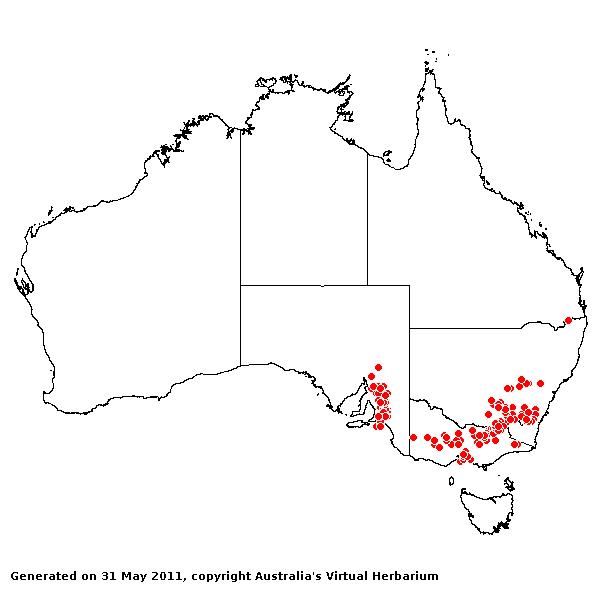Rytidosperma auriculatum (J.M.Black)
Connor & Edgar. New Zealand J. Bot. 17: 322 (1979).
Classification. (GPWG 2001) : Subfamily Danthonioideae. Tribe
Danthonieae.
Basionym and/or
Replacement Name: Danthonia auriculata
J.M. Black, Trans. & Proc. Roy. Soc. South Australia 53: 261
(1929).
Type of Basionym or
Protologue Information: LT: J.M. Black 2, 11 Nov 1927, Australia:
South Australia: Bundaleer Hills (K; ILT:: MEL). LT designated by Vickery,
Contr. New South Wales Herb. 2: 309 (1956).
Recent synonyms:
Notodanthonia auricalata (J.M.Black) Zotov, Austrodanthonia
auriculata (J.M. Black) H.P. Linder.
Key references
(books and floras): [2002] D.Sharp & B.K.Simon, AusGrass, Grasses of
Australia, [2006] J.Jessop, G.R.M.Dashorst, F.M.James, Grasses of South
Australia (286), [2008] S.W.L.Jacobs, R.D.B.Walley & D.J.B.Wheeler, Grasses
of New South Wales (141).
Illustrations:
[1984] N.T.Burbidge. rev. S.W.L.Jacobs, Australian Grasses (as D. auriculata), [2006] J.Jessop,
G.R.M.Dashorst, F.M.James, Grasses of South Australia (287, Fig. 221), [2008] S.W.L.Jacobs,
R.D.B.Whalley & D.J.B.Wheeler, Grasses of New South Wales, 4th edn
(141).
Derivation: L. auris,
ear; -ula, diminutive; -ata, possessing. The apex of the lemma
two-lobed.
Habit.
Perennial. Culms erect or geniculately ascending, 13–70 cm tall, 3 -noded.
Mid-culm nodes glabrous. Leaf-sheaths hairy. Ligule a fringe of hairs, 0.5 mm
long. Leaf-blades flat or involute, 2–10 cm long, 2 mm wide. Leaf-blade surface
indumented.
Inflorescence.
Inflorescence solid, a panicle. Panicle ovate, dense, 4 cm long, 2.5 cm wide.
Spikelets.
Spikelets pedicelled. Fertile spikelets many flowered, with at least 2 fertile
florets (5–7), comprising 5–7 fertile floret(s), with diminished florets at the
apex, cuneate, laterally compressed, 9–16 mm long.
Glumes. Glumes
similar, thinner than fertile lemma. Lower glume lanceolate, membranous, much
thinner on margins, without keels, 9–11 -nerved. Upper glume lanceolate, 9–16
mm long, membranous, without keels, 9–11 -nerved.
Florets.
Fertile lemma 2.5–3.5 mm long, without keel, 9 -nerved. Lemma apex lobed,
awned, 3 -awned. Median (principal) awn from a sinus, 11–13 mm long overall,
with a twisted column. Lateral lemma awns present. Lodicules present. Anthers
3. Grain 1.5–2 mm long.
Continental
Distribution: Australasia.
Australian
Distribution: South Australia, New South Wales, Victoria.
South Australia:
Flinders Ranges, Northern Lofty, Murray, Southern Lofty. New South Wales:
Central Coast, Southern Tablelands, Central-Western Slopes, South-Western
Slopes, South-Western Plains. Victoria: East Gippsland, Eastern
Highlands, Gippsland Plain, Grampians, Midlands, Riverina, Volcanic Plain,
Wimmera.
Notes. This
species is distinct by auricles flanking the lemmas, the central awn
approximately as long as the setae; the basal cluster of slender, rolled,
densely villous leaves; small, almost capitate inflorescences, and the villous
paleas. There are forms intermediate to R. erianthum, these are
discussed under the latter species.
Along
the western slopes from Dubbo to Adelaide, altitude 30–620 m, grassland in full
sun. Flowers Oct. to Nov.





